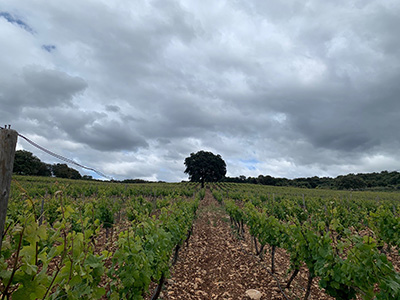Cortijo Los Aguilares
Puente de la Ventilla. Ctra. Ronda a Campillos, Km35. 29400 Ronda (Málaga)
www.cortijolosaguilares.com
One of the initiatives that has raised the profile of the wines of Ronda (Málaga), Cortijo Los Aguilares is the dream of Basque entrepreneur and wine lover José Antonio Itarte to make his own wine. To this end, in the 1990s he acquired a spectacular 800-hectare estate at the foot of the Sierra de Las Nieves, a protected natural area which was declared a Biosphere Reserve in 1995, where cereal and olive trees are also planted and Iberico pigs are raised. The vineyard, at an elevation of around 900 metres, benefits from significant thermal contrasts between day and night.
At the beginning Itarte was helped by winemaker Juan Manuel Vetas in the planting of the vineyard. Telmo Rodríguez and Pablo Eguzkiza, the duo behind Cía de Vinos, lent him a hand in the winemaking given Itarte’s strong friendship with Telmo’s father. In 2007, Seville-born Bibi García was appointed technical director. A chemist with a master in agronomics, she started her career in wine at Vall-Llach in Priorat (Catalonia) and studied Oenology in Cádiz. Among her classmates were some of the country’s leading wine producers such as Willy Pérez, Ramiro Ibáñez and Verónica Ortega.
Surrounded by mountains and framed by small valleys, the Cortijo Los Aguilares estate is largely dominated by holm oak groves. The terrain is hilly and the soils are very diverse with outcrops of Tertiary and Quaternary bedrock and chalky areas alternating with clay. In addition, there is an abundance of stone and quartz.
Eighteen hectares were planted between 1999 and 2000 to Tempranillo, Merlot, Cabernet, Petit Verdot and Pinot Noir. Whereas Petit Verdot was then regarded as an interesting variety in the area, Pinot Noir was a less obvious choice but was planted given Itiarte’s passion for red Burgundy. In general, international varieties were preferred because the vineyards in Ronda were lost to phylloxera. When Alfonso de Hohenlohe or Federico Schatz pioneered new plantings in the 1980s, they started from scratch because there was no historical identity to resort to.
For the last five years, Los Aguilares has also been managing the 10 hectares of the Hohenlohe vineyard in Las Monjas estate, one of the oldest in the area. This has enabled them to increase production and compensate for the frequent irregularity of harvests, which is partly due to the fact that vines are not irrigated. There is also a new five-hectare plot on the estate close to Puerto del Viento. Based on a soil study carried out by Claude and Lydia Bourguignon, they sought varieties that could adapt well to the terrain and provide freshness. In addition to Petit Verdot, Garnacha and Graciano are generously represented. In Ronda, Tempranillo lacks acidity, so it is often used for young wine, while Syrah alternates very good years with not so good ones. The whole vineyard is certified organic.
Production stands at around 120,000 bottles in a good vintage. The range starts with two young wines: CLA red and rosé (around €12 in Spain). Both are blends of Tempranillo, Garnacha and Syrah fermented in concrete tanks with no oak at all. Pago del Espino (€20) tries to capture the landscape of the estate. Petit Verdot accounts for 65% of the blend; the rest is completed with Syrah and Tempranillo. Ageing in big barrels helps to create a clean, fruit-driven style. With around 40,000 bottles, this is the wine with the highest availability alongside the young red.
Cortijo Los Aguilares has made a name for itself thanks to its Petit Verdot (6,000 bottles, €40) and particularly to its award-wining Pinot Noir (10,000 bottles, €37) despite the many difficulties to grow this variety in southern latitudes. Painstaking work has been carried out in the vineyard over the years: cordon royat training has been replaced by guyot, foliage is used to provide shadow for the bunches (“At this altitude, radiation is very high; pinot noir has a very delicate skin and the grapes here risk getting scorched”, says Bibi) and two harvests are regularly done: an early one to pick grapes with acidity; and a second one, almost two weeks later, to get ripe grapes and to allow the possibility to use some stems in fermentation. “We don’t crush grapes, macerations are short, and we barely touch the grapes,” she adds. Pinot Noir is not, in any case, a variety that is being considered for new plantings.
In contrast, Petit Verdot adapts really well to the soils and climate of Ronda. In this case the challenge for Cortijo de los Aguilares is just the opposite. They try to rein in its natural concentration and structure in the Tadeo Petit Verdot and search for elegance. There is a new Petit Verdot aged in clay vessel, Tadeo Tinaja, which feels rounder and more fruit-driven (around 1,000 bottles, €60).
There is a new white called Breñal (3,000 bottles, €29) made from Garnacha Blanca and small amounts of Viognier and Vijiriega Blanca. The grapes are grown in the winery's highest plot, at 900 metres above sea level. The wine has been aged for six months on its lees, partly in oak barrels, partly in stainless steel tanks.
Most popular
NEWSLETTER
Join our community of Spanish wine lovers


